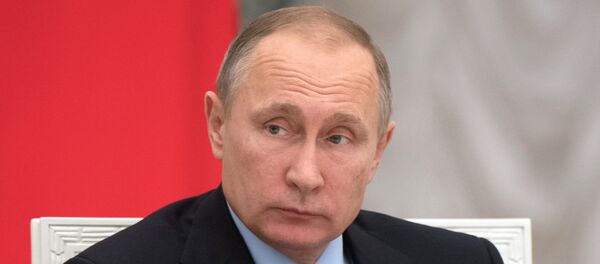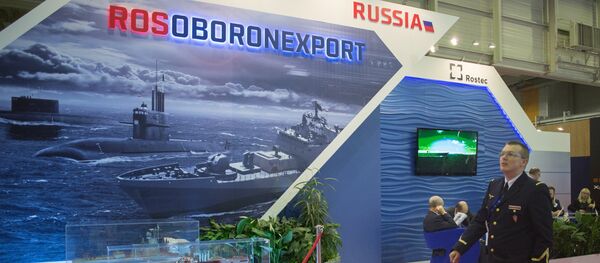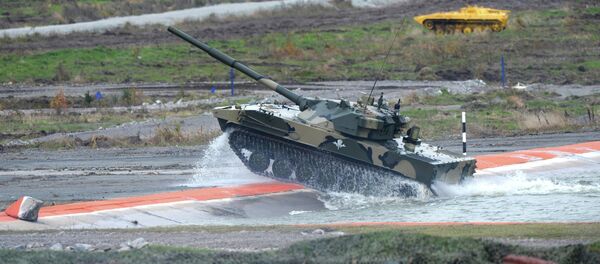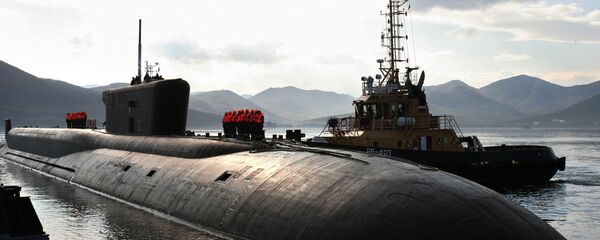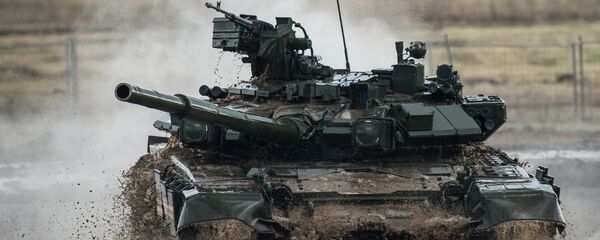MOSCOW (Sputnik) — Russia, the country now holding a quarter of global arms market, during the last decade has multiplied the exports of domestically developed weaponry abroad by three times reaching $14.5 billion in 2015, Sergei Chemezov, the head of Russia's Rostec Corporation, said earlier in December.
In 2016, the numbers could be surpassed despite the difficult geopolitical realities and Russia's shrinking overall exports, Chemezov added.
AVIATION
In 2016, Russia delivered its Sukhoi Su-30 Flanker-C fighter, a two-seat derivative of the earlier Su-27 Flanker with an extended operating range, capable of air-to-air and air-to-ground strikes and equipped with a wide variety of precision-guided munitions, to multiple foreign customers.
Besides, this year Russia finished delivery of 12 Su-30 MK2 fighters to Vietnam under the contract signed in 2013 worth about $600 million and delivered two Su-30SM multirole fighters to Kazakhstan as part of the deal to deliver 7 jets agreed last year.
Russia has also reportedly started delivery of its Mikoyan MiG-29 fighters to Algeria under a contract on 50 jets to be supplied by 2020 and delivered four Su-25 ground attack aircraft to Iraq.
On November 23, 2016, Russia handed over to Belarus four Yakovlev Yak-130 combat trainers in accordance with the agreement signed between the country’s Defense Ministry and the Russian Irkut Corporation in August 2015. In early 2015, Belarus received four such aircraft.
In October 2016, media reported that Egypt received the first batch of the advanced President-S onboard defense systems. A total of three units had been installed on Egypt’s Mil Mi-17 helicopters that have already taken part in anti-terrorist operations in the country.
The ODS is designed to protect planes and helicopters from being hit by missiles, air defense and anti-aircraft artillery. Apart from Egypt, according to the manufacturer, dozens of the systems were planned to be delivered to Algeria, India and Belarus in 2016.
Russia in 2016 also completed the delivery of 11 Mi-28 NE Night Hunter helicopters to Iraq under the contracts concluded in 2012-2013. The helicopters are actively participating in the anti-terrorist operations of the Iraqi army.
The Mi-35 is a modern multipurpose attack helicopter, equipped with the latest navigation and avionics technology, capable of operating in high temperatures and in mountainous terrain. It can also be used for medical and transportation purposes.
In November, Moscow and Beijing signed a contract on the delivery of two Russia-manufactured Beriev Be-200 amphibious aircraft to China stipulating an option to procure two more planes. The first delivery of the aircraft well suited to firefighting missions is scheduled for 2018. It can take in up to 12.5 metric tons of water in a few seconds while traveling over a body of water before dropping the load on the flames. One plane reportedly costs some $40 million.
In October 2016, media reported that China signed a contract on the delivery of 224 D-30KP2 engines worth over $658 million produced by Russia’s NPO Saturn Company. Fifty-four of them will be reportedly installed on Ilyshin Il-76/78 military transport aircraft operated by the Chinese Air Force while 170 units will be installed on China’s new Y-20 military transport plane.
Introduced in 2002, the Ka-226 series of helicopters are designed by the Kamov Design Bureau, part of the Russian Helicopters company. The Ka-226T model is fitted with updated navigation and automatic control equipment, as well as an interchangeable mission pod, which allows for flexible equipment configurations.
AIR DEFENSE SYSTEMS
Russia’s air defense systems in 2016 were traditionally popular among the foreign customers.
This fall, Russia finished executing the contract on the delivery of S-300 air defense systems to Iran. The $900-million contract to deliver five divisions of the defensive weaponry was signed in 2007. It was suspended after the adoption of UN Security Council sanctions on Iran in mid-2010. In April 2015, Russia resumed the talks on the S-300 deliveries following an agreement on the Iranian nuclear program.
Four divisions of the systems capable of striking tactical and strategic aircraft, medium-range ballistic missiles, tactical missiles as well as cruise missiles have been delivered in 2016 to Belarus.
Besides, in October, a deal on the deliveries of S-400 Triumf air defense systems was signed at a meeting of Russian President Vladimir Putin and Indian Prime Minister Narendra Modi on the sidelines of the BRICS summit in Goa.
The S-400 is Russia's next-generation air defense system, carrying three different types of missiles capable of destroying aerial targets at short-to-extremely long range. It is capable of tracking and destroying all existing aerial targets, including ballistics and cruise missiles.
NAVAL ARMAMENT
In February, Russia delivered to Vietnam a $600 million worth Varshavyanka-class Project 636 submarine while in early December it sent another vessel constructed by Russia’s Admiralty Shipyards.
Previously, Russia had supplied Vietnam with four diesel submarines within the framework of the agreement on the delivery of six Varshavyanka-class submarines.
Russia is also completing the construction of two Project 1166.1 Gepard 3.9 class frigates purchased by Vietnam. The warships are designed to engage surface ships, submarines and air targets, both independently and as part of a task force, as well as to perform escort and patrol tasks.
In October, Russia and India reached a deal on the delivery of three Admiral Grigorovich-class (Project 11356) guided missile frigates. The warships are powered by M90FR gas turbines built at Zorya-Mashproekt in Ukraine, a premier surface shipbuilder back in the Soviet era. However their delivery to Russia was halted due to Kiev’s export ban against Moscow in 2014. India could procure the turbines from Ukraine in a separate deal.
Besides, media reported citing Russian defense industry sources that Moscow and New Delhi agreed in October on a lease of Russia’s Project 971 nuclear submarine after its modernization.
COMBAT VEHICLES
Last month, India’s Defense Acquisition Council had cleared a proposal to acquire 464 Russia’s T-90 tanks for some $2.1 billion amid the delay in development of domestically-manufactured Arjun MK II main battle tank.
India reportedly intends to induct more than 1,600 of these tanks by 2020 that are expected to be deployed in the western part of the country bordering Pakistan.
Besides, according to media reports, Russia delivered dozens of T-90SA tanks to Algeria and up to 60 T-72B tanks to Uganda and agreed delivery of 170 T-72 tanks to Sudan and 39 such tanks to Serbia under deals expected to be implemented in the near future.
Russia also reportedly delivered in September up to 60 BTR-80 wheeled amphibious armored personnel carriers to Bangladesh under a contract on the supply of 330 such vehicles and 70 BTR-70M to Kirgizia in February. Among other deliveries that should be mentioned is the supply of a batch of Tigr all-terrain armored combat vehicles to Slovakia.

